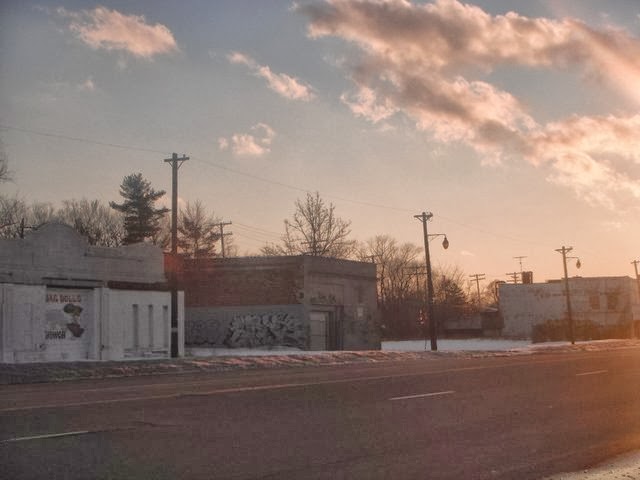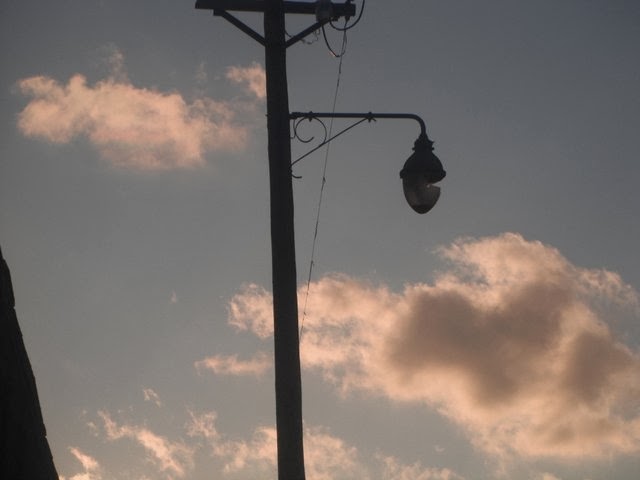Yet it was only weeks—if not days—after the declaration made
international news that, in order to convey to the world the magnitude of the
city’s financial woes, journalists honed in on more mundane failures—failures
that, by virtue of their banality, were all the more shocking. Locals have known about them for
ages. A portfolio of abandoned
public school real estate larger than many cities’ functional school systems. An absence of snowplows, even after
heavy storms. A stonewall of
silenced civil servants, hogtied from effectively carrying out duties by daily
uncertainty about the security of those same jobs. The virtual absence of any emergency response, resulting in
two-hour waits for an ambulance or a police call.
But the one that crowds out the rest, no doubt at least
partially due to its ubiquity and ordinariness, is the persistent
non-functionality of those streetlights.
One of the editorialists for the Free
Press has branded it “the city’s deepest embarrassment”.
By most estimates, up to 40% are out on any given night. Anyone passing
through can tell when crossing into the city limits for this exact reason: even
huge stretches of the interstates are black, although they’re state or federal
highways. It’s hard to determine if
these shadowy streets originate from a cash-strapped DPW’s inability to replace
the bulbs—which obviously require periodic maintenance—or an oversight that far
precedes the checkered Kilpatrick administration, when the city’s fiscal woes
first garnered national attention.
All it takes is a trip down Mack Avenue on the city’s east side to
postulate that the problem is a half-century in the making.
Silhouettes of streetlights punctuate the dusky penumbra, but
even at a distance, the shape of these lights seems odd. Antiquated? Probably. And a
closer view confirms it.
To be frank, I can’t recall seeing lights like this before
anywhere else in the country, and I’m well-traveled across some of the more
economically deprived pockets.
From the baroque iron filigree work of the stanchion to the acorn shape
of the light itself, my guess is this streetlight comes from an inventory that
most cities had fully retired over three decades ago. And there’s probably good reason for that: this one is
broken.
And so is another one half a block away.
About half of the lights along this stretch of Mack use this
design, and most are cracked. A
big distended bulb offers more surface area encased in glass—more space for
something to wrong. Whether hit by
flying debris hit or (my suspicion) deliberately smashed by a passer-by, this
streetlight is almost definitely non-operational. And the visible hardware is only half the problem: inside
that quaint, clunky bulb (your grandmother’s streetlight) is—or was—a mercury
vapor lamp. Detroit is one of the few cities that still depends heavily on this
less efficient, increasingly obsolete method of illumination; most other large cities have
replaced their inventory with superior metal halide lamps. USA Today also noted that Detroit and Milwaukee share the dubious distinction of being
the only large cities that still deploy series circuits for much of the
streetlight network, meaning that if one transformer box breaks down, the whole
strip of lights goes dark, like an old string of Christmas tree lights. While the Mack Avenue streetlight
featured above remains attached to a wood, other lights in the city append to
metal poles, presumably the same age as the lights themselves, characterized by
rust, peeling paint, and sometimes even open cavities at the base. The whole contraption has seen better
days.
But viewing these cracked eggs through a cultural lens can
help temper some of the scorn. They
might not work well as modern lamps and they’re much easier to vandalize, but
they’re relics—they’re curiosity items.
And they’re particularly eye-catching along Mack Avenue because there
are so many of them, yet they’re still interspersed with more contemporary
designs. This cool pic doesn’t win
awards for clarity, but it still shows the juxtaposition of old and new
streetlights, through their silhouettes.
Or on opposite sides of the street.
And on a depopulated residential street not so far from
Mack, a different kind of lighting style emerges—perhaps not as old-fashioned
but still an oddity.
Perhaps a style and technology that never caught on?
The irony of the 1950s-era (or maybe even 1940s) lighting
that lingers on in Detroit is that, in a broader spatial context, it
exemplifies technological advancements playfully defying shifts in taste
culture for a particular design.
On Mack Avenue, ancient streetlights bespeak a broke, ineffective
government. And yet, elsewhere in
the metro, they convey something else.
Forgiving the quality of the photo, it’s still easy to see a
similar style of lighting to the ones on Mack Avenue, but this time they’re impeccable.
But this is the comfy suburb of Livonia, presumably part of
a streetscape improvement along a thoroughly auto-oriented corridor of strip
malls and big boxes. And they no
doubt were a deliberate choice from the Public Works Department because they look good—providing a vintage, old-timey
feel. Apparently they don’t worry
in Livonia about ne’er-do-well pedestrians throwing rocks at these distended
bulbs. Maybe it’s because Livonia
has few ne’er-do-wells….and even fewer pedestrians. But even some of the economically healthier neighborhoods
within Detroit have caught the bug, replacing older streetlights with a newly
vintage design, like these twin lamps in Midtown, near Woodward Avenue:
This inversion of taste cultures pervades streetscapes
across the country, where everything old is new again, in order to exploit
nostalgia among a generation that never really experienced a normative walkable
environment—a landscape that was still the standard during the era when city
crew first installed those acorn mercury vapor lamps. We’re seduced by nostalgia and novelty; a hybrid of the two
is doubly sweet. Just go to the French
Quarter in New Orleans, where a city equally negligent in modernizing its
utilities now capitalizes on this same inertia—the flickery gas lanterns that
once were a backwater embarrassment are now ambiance. Detroit isn’t yet so lucky to take similar advantage of its
obsolete lighting (and the fact that most streets like Mack are a hodgepodge of
styles doesn’t help), but that doesn’t mean that an emergent cultural voice
won’t someday call those lights “genuine retro”, and the preached-upon choir will
be listening.
The periodic “freshening” of basic urban infrastructure is
only partly due to necessity, as it may very well be in Detroit. But a great deal simply has to do with
keeping up with the joneses, resulting in often needlessly costly capital investments. For example, the standard for
pedestrian signals at intersections now typically involves a “countdown” timer,
telling pedestrians exactly how many seconds they have left to cross. While useful, are these timer boxes
essential? Regardless, public
works departments are rapidly phasing out the single-box approach for these new
timer-boxes, with little evidence of public advocacy one way or another
(despite the fact that the public inevitably is paying for most of these
replacement costs). From
decorative viaducts to Day-Glo yellow road caution signs, jurisdictions hell-bent
on an infrastructural one-upmanship should look to Detroit as an inverse
exemplar—what might happen when profligacy goes perpetually unchecked. Unless, of course, these granny-and-gramps
streetlights become hip and cool again, in which case the Motor City might have
the last laugh.


























